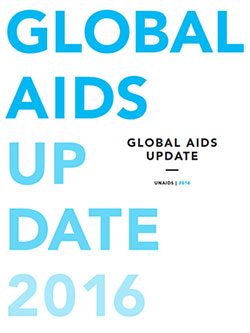Treatment scale-up progresses but incidence in Eastern Europe and Central Asia rises by 57%
A new UNAIDS report reveals progress on treatment and reduction in deaths, but the persistence of glaring disparities across countries, regions, and demographic groups. The report comes in advance of the United Nations General Assembly High-Level Meeting on Ending AIDS in New York, June 8−10.
 According to Global AIDS Update 2016, while the number of newly infected has remained stable in most regions and has declined by 4% in Eastern and Southern Africa, the annual number of new HIV infections in Eastern Europe and Central Asia increased by 57 percent over the past five years.
According to Global AIDS Update 2016, while the number of newly infected has remained stable in most regions and has declined by 4% in Eastern and Southern Africa, the annual number of new HIV infections in Eastern Europe and Central Asia increased by 57 percent over the past five years.
UNAIDS found that adolescent girls and young women 15–24 years old accounted for 20% of new HIV infections among adults globally in 2015, despite accounting for just 11% of the adult population.
The report also found that more than 90% of new HIV infections in central Asia, Europe, North America, the Middle East, and North Africa in 2014 were among people from key populations and their sexual partners, including gay men and other men who have sex with men, sex workers, and people who inject drugs.
“We need a people-centered response to the AIDS epidemic that removes all obstacles in the path of people’s access to HIV prevention and treatment services,” said UNAIDS Executive Director Michel Sidibé. “These services must be fully funded and appropriate to people’s needs so that we can end the AIDS epidemic for everybody.”
UNAIDS also announced that 2 million more people worldwide had gained access to antiretroviral medicines in the past 12 months, bringing the total to 17 million. The unprecedented increase since 2010 in many of the world’s most affected countries has reduced AIDS-related deaths from 1.5 million in 2010 to 1.1 million in 2015.
Global coverage of antiretroviral therapy reached 46% at the end of 2015; gains were greatest in the world’s most affected region, Eastern and Southern Africa, where coverage increased from 24% in 2010 to 54% in 2015, reaching a regional total of 10.3 million people.
At the High-Level Meeting on Ending AIDS, delegates are expected to adopt the 2016 Political Declaration on the Fast-Track to end AIDS in the age of Sustainable Development, which sets out a clear agenda to hasten the response to HIV/AIDS by 2020 and put the world on track to end the epidemic as a public health threat by 2030.
The “zero draft,” which builds on previous declarations, includes about 75 action items, including empowering women and girls, ensuring access to high-quality, evidence-based HIV information, education, and services, reducing transmission of HIV among people who inject drugs, and removing punitive laws, policies, and practices that block access to HIV services.
The declaration also includes a commitment to reduce the number of people newly infected with HIV to fewer than 500,000 per year by 2020 and people dying from AIDS-related causes to fewer than 500,000 per year by 2020.
See the complete UNAIDS report here:
http://www.unaids.org/sites/default/files/media_asset/global-AIDS-update-2016_en.pdf